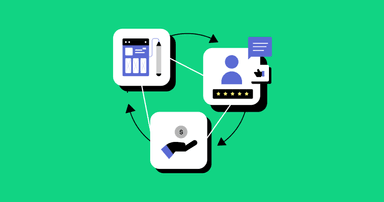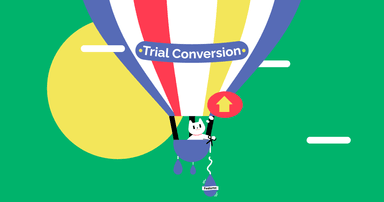The Supreme Court’s stance on Epic vs. Apple case: What this means for App Store monetization
Everything we now know about the ruling and its impact on how you’re allowed to monetize your users.


Rik Haandrikman
Finally, you’ll no longer have to pay Apple its 30%! Now, you can just pay them 27%… Plus whatever you pay your other payment processor. And that doesn’t take into account the added friction for your users and the impact that has on conversion.
We’ve gathered up everything we now know about the US Supreme Court ruling in the Epic Games vs. Apple case, and its impact on how you’re allowed to monetize your users going forward. In this blog you’ll find:
- The Apple-Epic Supreme Court ruling and what it actually means
- First responses from the app industry on the new Apple-Epic ruling
- The historical context of the Apple-Epic Supreme Court ruling
- How similar changes to App Store IAP rules played out in other countries
- What to expect next in terms of alternative payment methods and other App Store changes
The January 16th 2024 Epic vs. Apple Supreme Court ruling and what it means for monetizing US users today
Based on recent changes to the iOS App Store guidelines for the United States, you’re now allowed to direct users to alternative payment methods outside of the App Store. This follows the legal battle between Apple and Epic Games and a subsequent decision by the US Supreme Court.
The actual court documents, and the subsequent response from Apple’s side, make for a long and difficult read, but main aspects of these changes are:
- Linking to alternative payment methods: You can now include links in your apps that direct users to external websites for purchasing, via the StoreKit External Purchase Link Entitlement (US) system (found here in Apple’s Developer docs). This allows developers to inform users about alternative purchasing options, which may offer lower prices compared to in-app purchases. However, you have to apply (and get approved by Apple) to use this system, and are only able to use it in the USA
- Limitations on entitlement link usage: Links to external websites for purchasing are subject to a range of restrictions, including:
- Just being allowed one link in one place in the app
- Not being able to put that link in a popup or interstitial
- Not being able to put that link on your in-app purchase screen
- Requiring the link to open a new browser window, rather than a web view
- Not being able to pass additional information, such as the user ID, when opening the browser
- And more
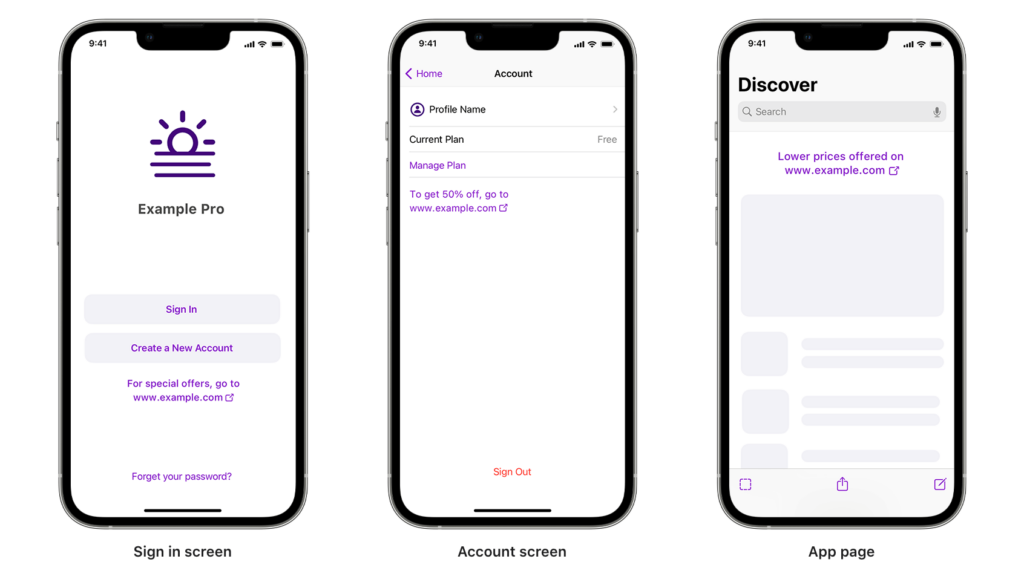
- Apple’s commission on external payments: Despite allowing external payment options, Apple will still collect a commission on those transactions. The commission rate is set at 27%, or 12% for developers who are part of the App Store Small Business Program and subscriptions after their first year (which basically means 3% less than the commission on an in-app purchase). This commission applies to purchases made within seven days of a user tapping on an External Purchase Link
- Reporting, auditing, and enforcement: Apple acknowledges the practical challenges in enforcing the collection of commissions on external transactions. Developers are required to provide monthly accounting of qualifying out-of-app purchases within 15 days after month’s end, according to these examples, and Apple reserves the right to audit these records. Apple also admits that ensuring compliance and collecting these commissions will be “exceedingly difficult and, in many cases, impossible” (which doesn’t excuse you from the need to submit these records, even in periods where you’ve seen no transactions).
And as the proverbial cherry on top of the pie, this in-app system disclosure sheet is what Apple will pop up whenever your app calls the StoreKit External Purchase Link API:
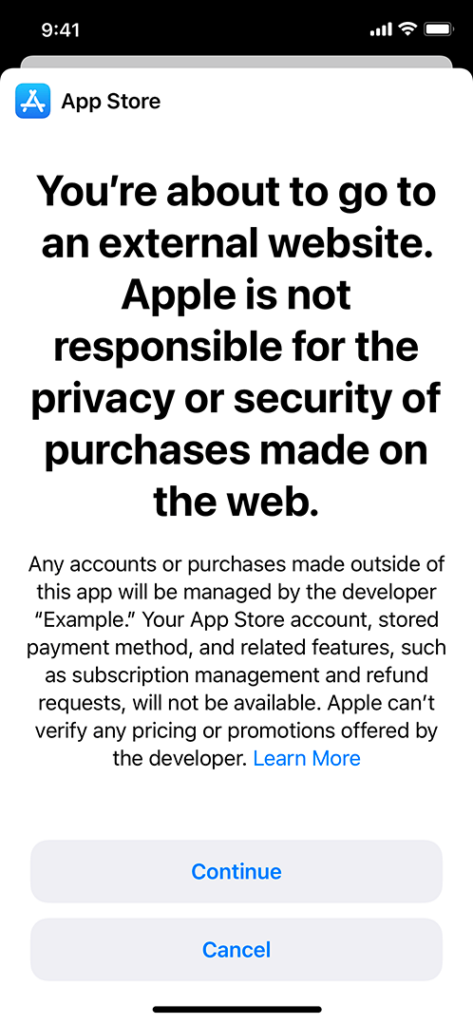
What app developers should do now
There is no sugar coating it: it is close to impossible to implement external purchases with this entitlement in a way that makes sense for app developers. Even leaving aside the fact that you can only link to these external purchases from one screen, which also can’t be your paywall, you simply can’t make the economics work. Payment gateways like Stripe usually charge about 3% transaction fees, so if you add that and Apple’s commission you end up at the same commission you would have paid for in-app purchases to begin with. However, actual conversion rates on external purchases will be much lower, because of several additional points of friction:
- Having to confirm the “scare modal”
- Having to log in again on the website (since passing in additional information is disallowed “in order to protect the user (for example, their privacy)”)
- Having to enter credit card information (as opposed to just paying for an in-app purchase using Face ID or Touch ID)
In summary: as an app developer, your time is better spent elsewhere other than implementing this new entitlement. If you want to consider web payments because of the higher margin, then web acquisition campaigns or email campaigns are better opportunities.
Developer and public response to the Epic vs. Apple Supreme Court ruling
There has been some criticism of these changes.
Epic Games’ CEO, Tim Sweeney, called the new policy out as anticompetitive, mentioning – among other things – the 27% commission on web purchases:
Apple filed a bad-faith "compliance" plan for the District Court's injunction. It totally undermines the order allowing “buttons, external links, or other calls to action that direct customers to purchasing mechanisms, in addition to IAP”.https://t.co/ofbuMwe7SH
— Tim Sweeney (@TimSweeneyEpic) January 16, 2024
David Heinemeier Hansson, co-founder of the Hey email app, has some strong words about the updates, describing it as Apple ‘poisoning’ the one victory Epic had in its lawsuit:
Apple is going to poison the one victory Epic secured in their lawsuit so bad nobody would ever think to use it. They want a 27%(!!!!) commission on any link from an app to a website, reporting every few weeks, AND the right to audit your books?? Insane. pic.twitter.com/Nn6wbNXHZD
— DHH (@dhh) January 16, 2024
Senior editor for The Verge, Tom Warren, called Apple’s interpretation of the ruling a “farce”, linking to an article about the changes penned by Jay Peters:
Apple’s App Store policies now let US developers link to outside payments. Apple is still taking a 27 percent cut though, so there’s essentially no difference for devs by the time they’ve paid payment processing fees elsewhere. What a farce https://t.co/49pOJAiA8q
— Tom Warren (@tomwarren) January 16, 2024
The historical context of the Epic vs. Apple Supreme Court ruling
Onset of legal action
The conflict between Epic Games and Apple began in August 2020 with Epic’s “Project Liberty,” a strategic move to challenge Apple and Google’s app store policies. Epic Games introduced a direct payment option in its popular game Fortnite, bypassing the Apple and Google payment systems and offering a discount to users who used this method. This action violated the terms of service of both the App Store and Google Play Store, leading to Fortnite’s removal from these platforms. In response, Epic Games filed lawsuits against Apple and Google, alleging antitrust and anticompetitive behavior in their respective app stores.
Epic’s strategy and Apple’s response
Epic Games’ strategy included a PR campaign with the hashtag #FreeFortnite and a parody video of Apple’s famous “1984” commercial. Apple retaliated by threatening to terminate all of Epic’s developer accounts and cut off access to iOS and Mac development tools, which would have impacted not only Fortnite but also the broader range of apps and games using Epic’s Unreal Engine. This led to Epic filing for a temporary restraining order against Apple.
Court rulings and appeals
In the following legal battle Apple largely won, with a judge ruling that they were not acting as a monopolist. However, the court did object to Apple’s anti-steering policies, which restricted developers from informing customers about alternative payment methods inside and outside of the app. Apple was ordered to allow:
- Linking to external purchases from the app
- Communicating alternative purchase options outside of the app (eg., via email)
Apple already implemented changes to allow communicating alternative purchase options outside of the app in 2021, so the only part of the injunction that is still relevant in 2024 is about linking to external purchases from the app.
Both Apple and Epic appealed the court decision, with the case eventually reaching the U.S. Supreme Court. In January 2024, the Supreme Court declined to hear those appeals, effectively making the lower court’s rulings permanent.
How App Store policy changes played out in South Korea and The Netherlands
The impact of previous App Store policy changes in South Korea and the Netherlands provide a glimpse into how this new US ruling will impact the market.
South Korea
In South Korea, the Telecommunication Business Act (found here in English on the website of the Korea Legislation Translate Center) was updated to address dominance of app store operators like Apple and Google, particularly concerning their commission fees on in-app purchases. This law required these companies to allow developers to use third-party payment systems. However, there have been challenges in implementation. Late 2023, the Korea Communications Commission (KCC) said that Google and Apple’s requirement to only allow certain payment methods, and Apple’s “discriminatory charging of fees to domestic app developers” undermined the law’s purpose of promoting fair competition.
A statement which follows a lack of real shift of spend from native in-app purchases to other payment methods, as evidenced by in-app purchase data from companies like data.ai:
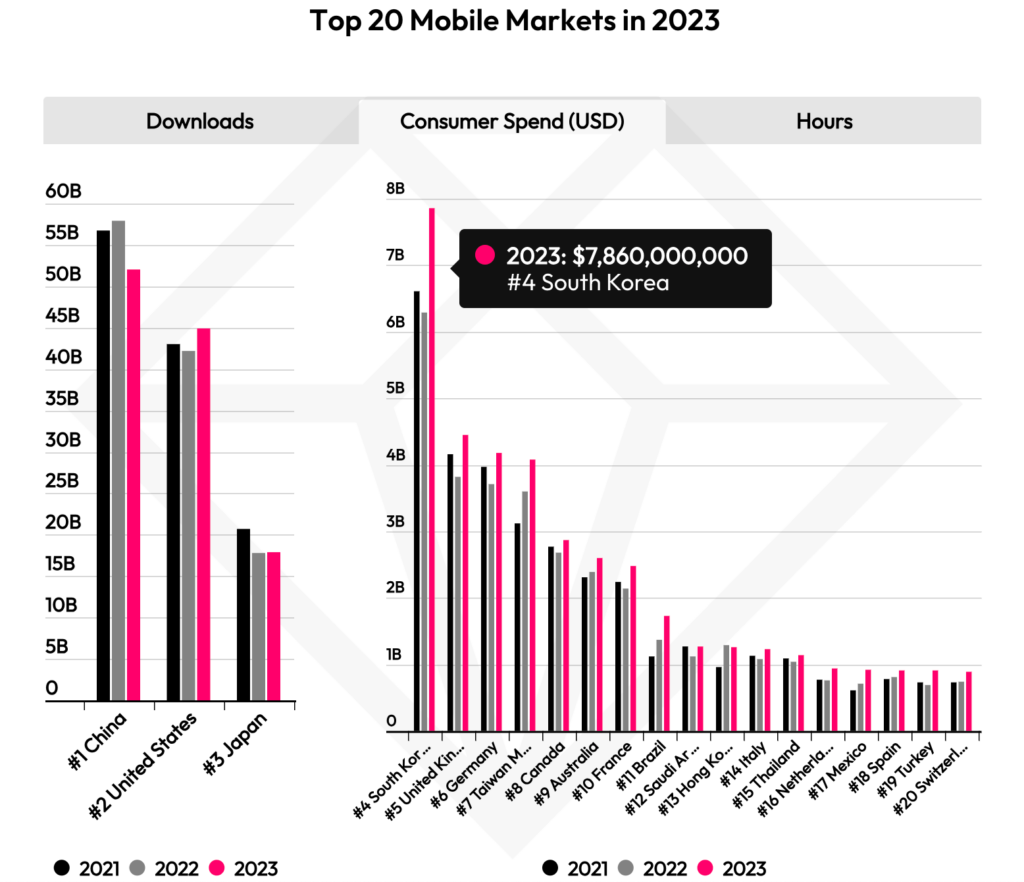
The Netherlands
In the Netherlands, the focus was more specific, targeting dating apps. The Authority for Consumers and Markets (ACM) launched an investigation into Apple’s requirement for app developers to use its in-app payment system. This led to changes in policy that go quite a bit further than the ones instituted for the US right now. Notably, in addition to the external purchase link available in the US, dating apps are allowed to offer purchases powered by an external payment provider in their app. Like the external purchase link, the requirements to offer this other payment method are extensive. Developers need to apply for permission, need to report on their earnings, still pay a 27% or 12% commission, and will trigger a warning modal served by Apple to users before they reach the developer’s in-app storefront:
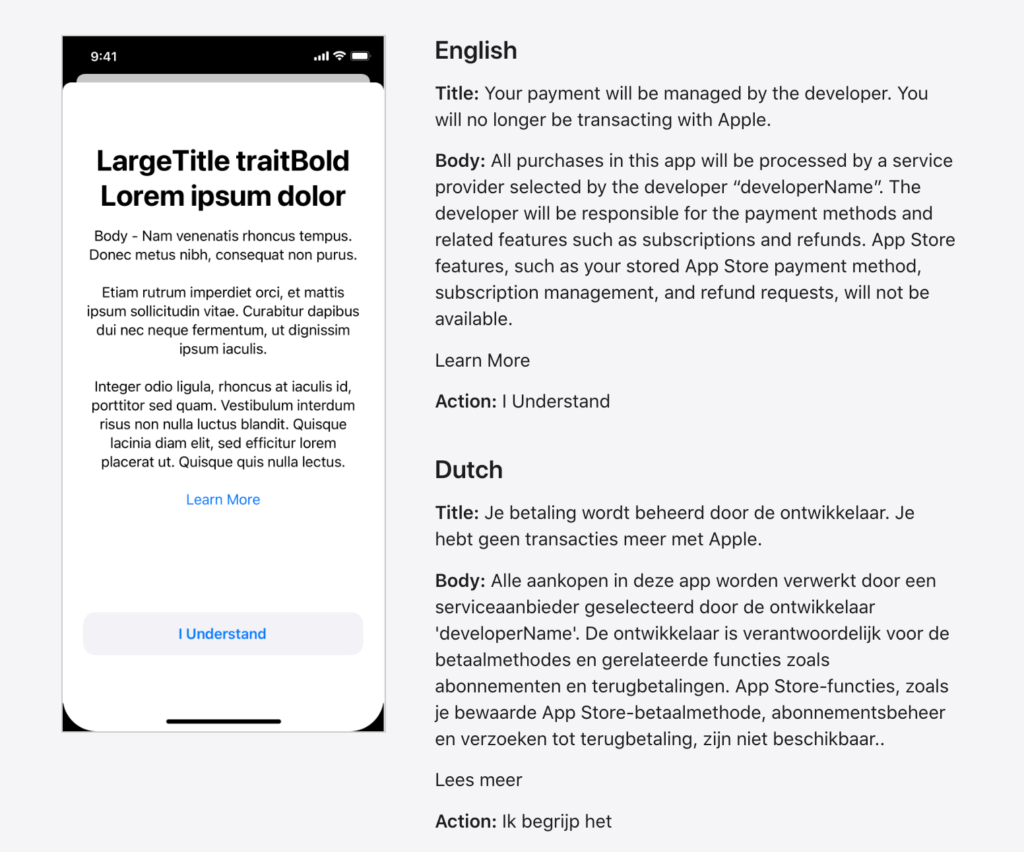
Even though Apple’s position is that these changes now make them compliant with the ACM’s requirements, part of their compliance is the subject of ongoing litigation in the Dutch courts. Exactly where Apple isn’t in compliance is unclear, though, as part of the ruling is currently deemed “confidential”, as shown in this July 2023 document from the ACM:

What to expect next in terms of alternative payment methods and other App Store changes
Based on the developments in South Korea and The Netherlands so far, there are two initial outcomes we can expect from the Apple vs Epic lawsuit and the subsequent App Store changes in the US:
- Apple’s changes might be deemed as ‘undermining’ the purpose of the ruling, but going through the legal motions will take time, and then would likely only lead to small, incremental changes, since Apple has consistently only done the minimum amount it can to follow the letter of the law. Additionally, it is worth noting that the original court decision explicitly allowed Apple to charge commissions for web purchases: “IAP is the method by which Apple collects its licensing fee from developers for the use of Apple’s intellectual property. Even in the absence of IAP, Apple could still charge a commission on developers. It would simply be more difficult for Apple to collect that commission.”
- For the foreseeable future, in-app purchase revenue won’t see a significant shift to alternative payment methods, since it won’t make economic sense for developers to implement external purchase links:
- There’s minimal potential upside thanks to the commissions on external purchases
- Developer incur additional costs related to administrative overhead
- Conversion rates are likely to be lower thanks to the UX challenges posed by Apple’s requirements around how and where to display external purchase links
Ongoing legal and regulatory challenges
The Supreme Court’s decision is unlikely to be the last time Apple’s hold on the iOS App Store is challenged in courts. Epic Games CEO Tim Sweeney has expressed dissatisfaction with the Supreme Court’s decision and has indicated that the fight against what they perceive as Apple’s anticompetitive practices will continue.
It’s likely that the outcome of this case, along with similar regulatory actions globally will serve as a catalyst for further changes in app store policies. It will influence future legislation and regulatory decisions in other regions, including the European Union’s Digital Markets Act set to take effect soon.
In-App Subscriptions Made Easy
See why thousands of the world's tops apps use RevenueCat to power in-app purchases, analyze subscription data, and grow revenue on iOS, Android, and the web.
